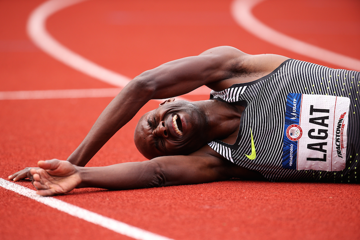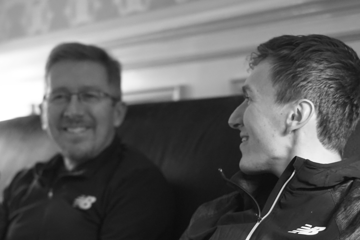Kemoy Campbell during practice (© Dan Vernon)
Growing up, Jamaica's Kemoy Campbell had no path to follow in his dream to become a top distance runner. So he made his own.
As you might expect, it all started against his will.
The story of Jamaica’s first world-class distance runner begins at a school sports day, where a 15-year-old Kemoy Campbell is approached by his music teacher at Bellefield High School.
Campbell was short, skinny, one of five children who had grown up on a farm in rural Jamaica, and he’d never shown much promise at sport. In cricket, he could field pretty well but couldn’t catch a ball to save his life and as for soccer, well, let’s just not go there.
Not having any real concept of distance, he agreed to his teacher’s request to run the 5K, and then sidled over to the start line in blissful ignorance.
“How many laps?” he asked he starter.
“Twelve and a half,” came the response, much to Campbell’s horror.
“I started walking off because I thought I couldn’t do it,” he recalls, “but the starter told me I was already on the line so I might as well.”
Campbell stuck it out, finishing third and beating most of his rivals. Later that night, back on the family farm, he told his aunt about the race and she encouraged him to give distance-running a try, having no idea what she was about to start.
Because 12 years on, that wiry kid has grown up to become a professional athlete, an Olympian, a world finalist – one who beat all the Kenyans and finished 10th in the 5000m final in London last year.
From Manchester Parish, Jamaica to South Plains, Texas to Fayetteville, Arkansas, his talent has taken him far and wide, and these days he endures the freezing winters of Boston, where Campbell has been cool-running his way to the top tier of global distance running.
“Put a Jamaican outside in a place like this, running 10 miles in the cold, it sounds like a joke,” he says. “But I know what I want and I know how to get it.”
Feel the Rhythm
In the beginning, long before he ran for time, place, money or joy, Campbell ran just to impress his parents.
They’d send him to the local shops to pick up groceries, and each time he’d time himself sprinting down the country roads at a ferocious rhthym, scrambling around the shop and then dashing back to the farm. “I’d try to beat my time every single time I went,” he says. “I used to like the compliments from my family that I went really fast.”
He figures today that the distance was only about 500 metres, but little did Campbell know on those childhood runs that he was building an engine that would take him to a place he never thought possible.
Years later his high school coach, Dean Tomlin, would open his eyes to the possibilities of athletics, how it could earn him a scholarship to receive a free college education in the US.
In 2007 he qualified to run at the IAAF World Youth Championships in Ostrava, but got a rude awakening against the world’s best, eventually dropping out of his 3000m heat. In his final year of school in 2010, his coach told him a big performance was needed at ‘Champs’, the meeting that gathers the best teenage talent in Jamaica, and with it a horde of recruiters from US colleges.
Campbell aced his final exam, winning the 1500m in 3:45.54 and 5000m in 14:18.55. Jamaica’s got talent, they soon realised, and not just in the sprints.
Going it alone
His first year away from home was tough, lonely – Campbell accepting a scholarship to South Plains College in Texas, a feeder college to many of the bigger universities. Having grown up in a busy household, he’d been used to falling asleep mid-conversation with his brother, and without that company he struggled to sleep for many months in Texas.
“I always consider myself independent,” he says. “Eventually I got used to the feeling of being alone.”
After two years he transferred to the University of Arkansas, an institution that churns out world-class athletes with astonishing frequency. There, he finished second in the NCAA indoor 3000m in 7:46.95, then lowered his 5000m best to 13:32.82. He missed 2014 with injury, but Campbell kept ploughing away on the bike and in the pool, preparing for a big year in 2015, when he lowered his 5000m best to 13:20.39, a Jamaican record, and secured a spot at the IAAF World Championships in Beijing.
In what was his first major championship at senior level, he fell in his 5000m heat and trailed home 14th in 14:00.55, but the experience proved valuable when he took to the Olympic stage a year later in Rio. He got much closer there, finishing 10th of 25 in his 5000m heat, having learned how to race the very best in the world.
“It’s always a pleasure lining up with the great athletes like [Mo] Farah and [Paul] Chelimo,”he says. “If I race the best, one day I’ll be able to become the best because they’ll always push you to a new limit.”
Then there was London, his second world championships, where Campbell reached the world 5000m final last year and lined up amid a raucous atmosphere. He finished 10th, just seven seconds behind gold medallist Muktar Edris.
“It was a great experience,” says Campbell. “Maybe the best.”
Carving his own path
In the hierarchy of Jamaican athletics, Campbell knows his achievements will always play second fiddle. It is, after all, the sprinting superpower, a nation obsessed with speed but much less so with endurance.
“Jamaicans don’t get to see much of what I’m doing so I don’t get much as much exposure but I’m self-motivated,” says Campbell. “I learned to do it for myself and then the only person I can let down is me.”
For the past two years he’s been based in Boston, training until recently under coach Mark Coogan, but at least once a year Campbell gets back to Jamaica, where the questions still persist about his unusual career choice.
He tells the story of a discussion with a younger Jamaican distance runner who quizzed him about his training, and Campbell happily explained his routine: 10 miles in the morning, five in the evening, 105 miles a week while in base training and a little less in summer. The younger runner was stunned, and told Campbell he’d never have time for that workload.
“I tried to explain you have to make the time if you want to be a great distance runner,” says Campbell. “You have to put the time and effort in, but he couldn’t comprehend I was doing that much.”
It explains, perhaps, why Campbell stands as the sole world-class Jamaican male distance runner, and why he holds every national record from 3000m to 10,000m.
This Saturday in Boston, he plans to strengthen his grip on the record books as he drops down to 1500m at the New Balance Indoor Grand Prix, the fourth stop on the IAAF World Indoor Tour.
The Jamaican indoor record is 3:40.7 and dates back to 1974, while the outdoor record is 3:39.19 and is now 24 years old. Campbell believes it’s time they were rewritten and told his agent, Ray Flynn, as much earlier this week.
“I haven’t run a 1500 in forever and haven’t done much speedwork, but I think I should be able to get it,” he says. “I’d like to see my name on every single distance record in Jamaica.”
Of course, he’s not alone in wearing the Jamaican vest with distinction in distance races, given Aisha Praught-Leer, who grew up in the US but switched allegiance to Jamaica in 2015, was an Olympic finalist in the 3000m steeplechase in 2016.
Campbell hopes that young Jamaicans see their exploits and take inspiration. “One of the reasons I’m doing this is to open the eyes of youths in Jamaica that they don’t have to be sprinters,” he says. “A lot of times people ask me why I run distance, but I enjoy it. I want the youth in Jamaica to realise they can get something out of it.”
Next month Campbell will don the Jamaican colours at the IAAF World Indoor Championships in Birmingham, and for the remainder of the year his goal is simple: run 13:10 or under for 5000m (his current best is 13:14.45). That, he believes, will be the next major step to becoming a medal contender at the 2020 Olympics in Tokyo, where he hopes to achieve his ultimate ambition.
“To prove a point,” he says, “that Jamaicans can do well no matter what race they’re in.”
Words: Cathal Dennehy
Training photos: Dan Vernon








